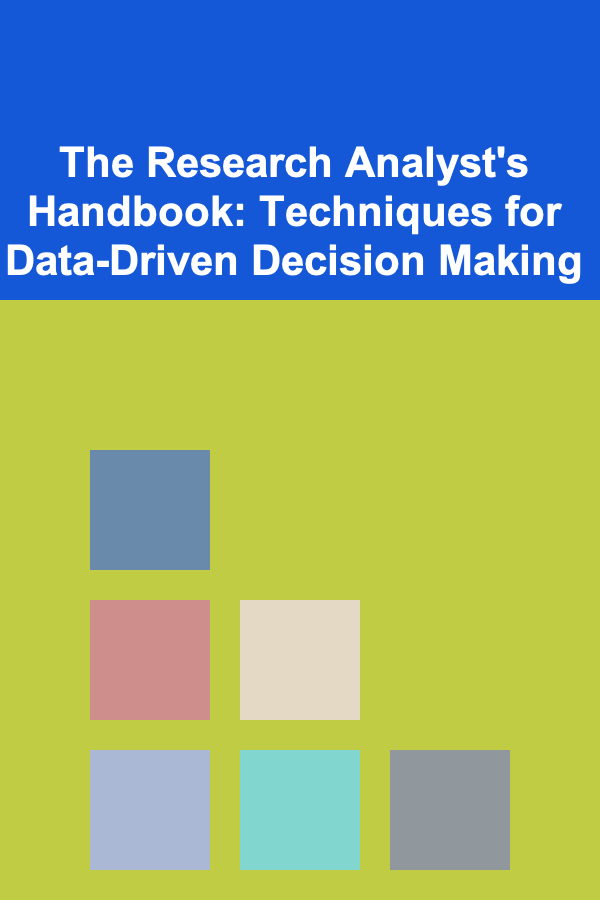
The Research Analyst's Handbook: Techniques for Data-Driven Decision Making
ebook include PDF & Audio bundle (Micro Guide)
$12.99$6.99
Limited Time Offer! Order within the next:

Data-driven decision making (DDDM) has become a cornerstone of modern business strategy, scientific discovery, and policy formulation. Research analysts are the driving force behind this process, transforming raw data into actionable insights that guide critical decisions. In this handbook, we'll delve into the techniques, tools, and best practices that research analysts can employ to enhance the quality and impact of their work. Whether you're new to the field or a seasoned professional, this guide will provide a comprehensive overview of the methods and strategies necessary for making data-driven decisions.
Understanding the Role of a Research Analyst
A research analyst's primary role is to collect, analyze, and interpret data to inform decisions. They may work in various fields, including finance, healthcare, marketing, social sciences, technology, and more. Their work usually involves identifying trends, testing hypotheses, and providing actionable insights to guide stakeholders in their decision-making processes.
The tasks of a research analyst typically include:
- Data Collection: Identifying relevant data sources and ensuring data accuracy.
- Data Analysis: Using statistical and computational techniques to analyze data.
- Insight Generation: Drawing conclusions and providing actionable recommendations.
- Reporting: Communicating findings clearly through reports, dashboards, or presentations.
Data Collection: Laying the Foundation for Effective Analysis
The first step in the data-driven decision-making process is data collection. High-quality analysis relies on having accurate, relevant, and reliable data. Research analysts must ensure that the data they collect aligns with the objectives of the analysis.
Key Techniques for Data Collection:
- Define Clear Objectives: Start by clarifying the research question or business problem. What are you trying to solve or understand? This will guide your data collection process and help you determine the type of data required.
- Choose Relevant Data Sources: Data can be collected from various sources, including surveys, databases, public records, sensors, and social media platforms. The source must be reliable and representative of the problem you're addressing.
- Leverage Big Data and Real-Time Data: In today's digital age, vast amounts of real-time data are available. Research analysts should be equipped to handle big data (large, complex datasets) and time-sensitive information. Technologies like Apache Hadoop, Apache Spark, and cloud computing tools can aid in managing these data sources.
- Focus on Data Quality: Ensure that the data is accurate, complete, and consistent. Poor-quality data can lead to misleading results and ultimately misguided decisions.
Data Cleaning: Ensuring Accuracy and Consistency
Once data has been collected, it's time to clean and preprocess it. Data cleaning is a crucial step because raw data often contains errors, inconsistencies, or missing values that could affect the results of the analysis. Cleaning the data is essential for ensuring the accuracy and reliability of your conclusions.
Steps for Effective Data Cleaning:
- Remove Duplicates: Duplicated records can skew analysis, so it's essential to eliminate them.
- Handle Missing Data: Missing values are common in real-world datasets. Depending on the data and the analysis requirements, you can handle missing data by removing records, using imputation techniques, or filling in values based on predictions.
- Correct Inconsistent Data: Data may sometimes be entered in different formats (e.g., "Yes" vs. "1"). Standardize the data for uniformity.
- Detect and Remove Outliers: Outliers---data points that fall far outside the general range of data---can distort analysis results. It's essential to assess whether outliers should be removed, corrected, or kept based on their relevance to the research.
Choosing the Right Analytical Techniques
The next step is selecting the appropriate analytical techniques that will yield meaningful insights from the data. The choice of methodology depends on the nature of the data, the research question, and the desired outcomes.
Common Analytical Techniques:
- Descriptive Statistics: This includes measures like mean, median, standard deviation, and frequency distributions. Descriptive statistics help summarize the basic features of the data and provide initial insights.
- Inferential Statistics: This includes techniques such as hypothesis testing, regression analysis, and correlation analysis. Inferential statistics help analysts make generalizations or predictions about a population based on sample data.
- Predictive Modeling: For data that involves forecasting or predicting future outcomes, predictive models such as linear regression, decision trees, or machine learning algorithms can be used to identify patterns and predict future events.
- Cluster Analysis: When dealing with large datasets or data from multiple variables, cluster analysis can help group similar data points together. This technique is useful in market segmentation, customer behavior analysis, and more.
- Time Series Analysis: When working with data collected over time, time series analysis is crucial for detecting trends, seasonal patterns, and forecasting future values. Methods like ARIMA (AutoRegressive Integrated Moving Average) can be used for modeling time-based data.
- Sentiment Analysis: For unstructured text data, such as customer reviews or social media posts, sentiment analysis can help determine the overall sentiment (positive, negative, neutral) of the data.
Choosing the Right Technique:
- Understand the Data Type: The analytical technique you choose should align with the type of data you have (quantitative vs. qualitative, continuous vs. categorical).
- Match the Technique to the Objective: Some techniques are better suited for descriptive insights, while others are designed for prediction or causal inference. Select a method based on what you aim to achieve.
- Test Assumptions: Every statistical technique comes with assumptions (e.g., normal distribution, linearity). Verify that your data meets these assumptions before applying a technique.
Statistical Testing and Validation
Statistical tests are the backbone of rigorous data analysis. They allow researchers to draw inferences about the population based on sample data and to assess the likelihood that their findings are due to chance.
Key Concepts in Statistical Testing:
- Hypothesis Testing: This is used to test assumptions or claims about a population. The null hypothesis (H₀) represents the status quo, and the alternative hypothesis (H₁) represents what the researcher is trying to prove. The significance level (p-value) determines the likelihood of rejecting the null hypothesis.
- Confidence Intervals: A confidence interval provides a range of values within which the true population parameter is likely to lie. It helps analysts gauge the precision of their estimates.
- Statistical Power: Power refers to the probability that a statistical test will detect an effect if there is one. Higher statistical power reduces the risk of Type II errors (failing to detect a true effect).
- Cross-Validation: Cross-validation is a technique used to assess the performance and reliability of predictive models by testing them on different subsets of the data. This helps prevent overfitting.
Data Visualization: Communicating Insights Effectively
Effective communication of data insights is just as important as the analysis itself. Data visualization plays a key role in this process, as it allows complex data and trends to be presented in an easily digestible format. A well-designed visualization can help stakeholders quickly grasp insights and make informed decisions.
Best Practices for Data Visualization:
- Keep It Simple: Avoid cluttering your visualizations with too much information. Use clear titles, labels, and legends to ensure the viewer understands what they're seeing.
- Choose the Right Visualization Type : The choice of visualization depends on the nature of the data. For example:
- Bar charts are ideal for comparing categories.
- Line graphs are best for showing trends over time.
- Scatter plots are useful for identifying relationships between variables.
- Focus on Key Insights: Highlight the most important findings in your visualizations. This could include emphasizing trends, outliers, or patterns.
- Use Interactive Dashboards: Tools like Tableau, Power BI, and Google Data Studio enable you to create interactive dashboards that allow users to explore the data and insights dynamically.
Communicating Findings and Recommendations
The final step in the research process is communicating your findings to stakeholders. A research analyst must present complex data and insights in a way that is clear, compelling, and actionable.
Tips for Effective Communication:
- Know Your Audience: Tailor your presentation to the level of technical expertise of your audience. For non-technical stakeholders, focus on high-level insights and practical recommendations.
- Tell a Story: Frame your findings within a narrative that explains the context, the analysis process, and the implications of the results. This makes the information more engaging and easier to understand.
- Provide Actionable Recommendations: Don't just present the data---offer specific recommendations based on your analysis. For example, if your analysis identifies a market trend, recommend actions the company can take to capitalize on it.
- Use Clear Visuals: Incorporate charts, graphs, and infographics to make your findings more accessible. Visuals can help simplify complex concepts and make your conclusions more persuasive.
Tools for Research Analysts
A research analyst's toolkit is essential for carrying out effective data analysis and decision-making. The right tools can significantly enhance the efficiency and accuracy of your work.
Popular Tools:
- Excel/Google Sheets: For basic data manipulation, analysis, and visualization.
- R and Python: Powerful programming languages for advanced data analysis and machine learning.
- Tableau/Power BI: For creating dynamic visualizations and interactive dashboards.
- SPSS/SAS: Statistical software used for advanced statistical analysis and data management.
- SQL: For querying and managing large datasets stored in relational databases.
Conclusion
Data-driven decision making is an essential skill in today's data-rich world. By mastering the techniques outlined in this handbook---ranging from data collection and analysis to visualization and communication---research analysts can provide invaluable insights that drive strategic decisions. Whether working in business, healthcare, government, or academia, the ability to analyze data rigorously and communicate findings effectively will empower you to make informed, impactful decisions.

How to Add Luxury Features to Your Home Renovation on a Budget
Read More
How to Create a Checklist for Effective Content Editing
Read More
How to Develop a Garden Maintenance Schedule
Read More
How to Grasp the Concepts of Impermanent Loss in DeFi
Read More
How to Prioritize What to Keep and What to Let Go
Read More
Scaling Passive Income by Offering Deep Learning as a Service
Read MoreOther Products

How to Add Luxury Features to Your Home Renovation on a Budget
Read More
How to Create a Checklist for Effective Content Editing
Read More
How to Develop a Garden Maintenance Schedule
Read More
How to Grasp the Concepts of Impermanent Loss in DeFi
Read More
How to Prioritize What to Keep and What to Let Go
Read More